다음 증상 징후가 신생아에게 있으면 감염병에 걸렸나 알아보기 위해 의사에게 즉시 문의 한다., Call the doctor immediately to find any kind of infectious diseases if you newborn infant has symptomes and signs such as followings
| 신생아에게 열이 날 때 |
Fever in newborn infants
- 날씨가 덥거나 실내의 온도가 너무 높을 때 아프지 않아도 신생아의 체온이 그 주위 온도에 따라 덩달아 올라가 정상 이상으로 높아질 수 있다.
- 그럴 때 어떤 감염병에 거려 앓지도 않는데 미열 내지 고열이 날 수 있다.
- 또 아무 이상도 질병도 없는 신생아를 두꺼운 담요나 포대기 등으로 너무 많이 꼭 싸 주거나 옷을 너무 많이 입힐 때도 신생아의 체온이 정상 이상으로 올라갈 수 있고 열이 날 수 있다. 그리고 신생아가 탈수될 수 있다. 탈수 인해 미열 내지 고열이 날 수 있다. 신생아가 탈 수되어 생긴 열을 신생아 탈수열이라 한다.
- 생명을 위협할 수 있는 폐렴, 뇌염, 패혈증 등을 앓을 때도 미열 내지 고열이 날 수 있다.
- 드물게는 생명을 위협할 수 있을 정도로 심각한 감염병을 앓고 있는 신생에게 고열이 나지 않고 오히려 미열이 나거나 저체온증이 생길 수 있다. [부모도 반의사가 되어야 한다-소아가정간호백과]-제21권 소아청소년 가정 간호-신생아의 체온 참조. 고열이 날 때, 열성 경련, 신생아 체온, 신생아 탈수열, 신생아가 열이 나면 어떻게 하나요, 열이 날 때 참조.
- 생후 28일 이전 아기들 즉 신생아들에게 100.4℉ 이상 또는 38℃ 이상 열이 나면 병원에 입원을 시키고 열나는 원인을 찾으면서 적절히 치료해 주라고 미소아청소년 학회에서는 권장한다.
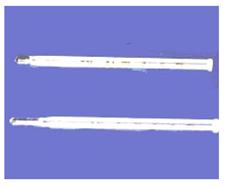
사진 71. 미국에서는 유리 수은 체온계로 체온을 재는 것을 더 이상 권장하지 않는다.
그러나 유리 수은 체온계로 체온을 재면 경제적이고 실용적이고 쓰기에도 간편하다. 필요에 따라 항문 체온계로 신생아의 항문에서 체온을 잴 수 있다.
Copyright ⓒ 2012 John Sangwon Lee, MD., FAAP
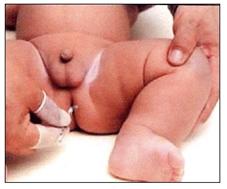
사진 72. 신생아에게 열이 나면 가능한 한 항문체온을 잰다. 항문 체온을 잴 때는 장갑을 끼고 체온을 잰다. 항문 체온을 잴 때 전자체온계나 수은 체온계를 사용할 수 있다.
Copyright ⓒ 2012 John Sangwon Lee, MD., FAAP
1. 신생아의 고열
- 갓 태어나서 생후 28일까지 기간을 신생아기라 하고 그 기간의 아기들을 신생아들이라고 한다.
- 생후 2~3일 경에 아무 감염병이 없는 신생아에게 생긴 탈수로 인해 열이 날 수 있다.
- 이 때 신생아가 모유나 인공영양을 충분히 섭취하지 못하고 생리적 체중감소 등으로 열이 날 수 있다.
- 또는 신생아가 다른 이유로 탈수되면서 신생아에게 고열이 날 수 있다. 이렇게 생긴 열을 신생아 탈수열이라 한다. 이때 병원 응급실로 바로 데리고 간다. 신생아 탈수열 참조.
- 신생아에게 생긴 선천성 바이러스 감염병, 후천성 바이러스 감염병, 또는 박테리아 감염병으로 열이 날 수 있다.
- 신생아에 생긴 어떤 감염성 감염병으로 인해 나는 열과 신생아 탈수열을 감별 진단해서 치료해야 한다.
- 전염병을 앓고 있지 않은 건강한 신생아에게 너무 옷을 많이 입히거나 아기를 두꺼운 담요 등으로 너무 싸주면 신생아에게 열이 날 수 있다.
- 보육기 내 온도가 상당히 높거나 실내 온도가 상당히 높으면 신생아의 체온이 비정상적으로 올라가서 열이 날 수 있다.
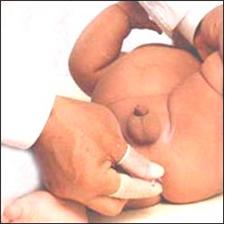
사진 12. 신생아에게 열이 나면 체온을 재고 즉시 단골 의사에게 문의하던지 소아청소년과나
Copyright ⓒ 2012 John Sangwon Lee, MD., FAAP
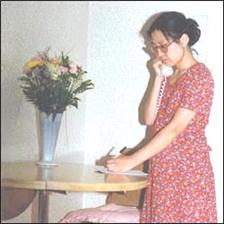
사진 13. 신생아 에게 열이 나면 의사에게 즉시 문의하던지 소아청소년과나 병원 응급실로 바로 데리고 간다.
Copyright ⓒ 2012 John Sangwon Lee, MD., FAAP
2. 신생아가 설사할 때(신생아의 설사)
- 건강한 신생아들의 대변은 설사 변처럼 묽은 물똥을 정상적으로 볼 수 있다.
- 이렇게 정상으로 보는 신생아의 묽은 대변을 설사라고 하지 않는다.
- 모유나 인공영양을 충분히 먹는 신생아들의 대변은 정상적으로 더 묽게 볼 수 있다.
- 바이러스 위장염이나 박테리아 위장염, 패혈증, 또는 다른 병을 앓을 때도 설사를 할 수 있다.
- 물똥을 눌 수 있다.
- 어떤 병으로 설사를 하면 신생아는 삽시간에 탈수가 되기 쉽고 그로 인해 생명을 위협할 정도로 심하게 앓을 수 있다. 그 때문에 설사를 하면 의사에게 곧 문의해 적절한 진단 치료를 받아야 한다.
- 신생아가 설사를 한다고 생각되면 지체 없이 의사에게 곧 문의해야 한다.
- [부모도 반의사가 되어야 한다- 소아가정간호백과]-제 9권 소아청소년 소화기 질환-그림 173 참조, 아기가 우유로 만든 인공영양을 먹을 수 없는 경우, 신생아 설사 참조
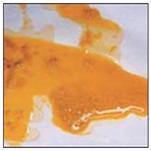
사진 76. 신생아 설사변
Copyright ⓒ 2012 John Sangwon Lee, MD., FAAP
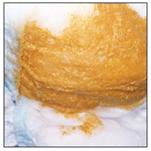
사진 77. 모유를 먹는 신생아의 정상변
Copyright ⓒ 2011 John Sangwon Lee, MD., FAAP
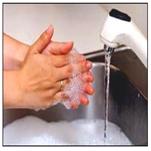
사진 78. 신생아를 양육할 때도 손을 깨끗이 씻어 감염병을 예방한다.
Copyright ⓒ 2011 John Sangwon Lee, MD., FAAP
Call the doctor immediately to find any kind of infectious diseases if your newborn infant has symptoms and signs such as followings
When your newborn has a fever
Fever in newborn infants
• When the weather is hot or the temperature in the room is too hot, even if you are not sick, your baby’s body temperature can rise to more than normal depending on the surrounding temperature.
• In that case, you may have a low or high fever even though you do not suffer from any infectious disease.
• Also, if a newborn baby who is not sick is wrapped too tightly in thick blankets or swaddling clothes or dressed too much, the baby’s body temperature may rise above normal and may develop a fever. And newborns can become dehydrated. Dehydration may cause mild to high fever. Fever caused by dehydration in newborns is called neonatal dehydration fever.
• You may also have a low or high fever when suffering from life-threatening pneumonia, encephalitis, or sepsis.
• Rarely, a newborn with a serious, life-threatening infectious disease may develop a low fever or hypothermia rather than a high fever. [Parents should also become at least the half-doctors – Encyclopedia of Pediatric and Family Nursing] – Vol. 21 Child and Adolescent Home Nursing – Refer to the body temperature of a newborn.
See Fever, Febrile Cramps, Newborn Body Temperature, Newborn Dehydration Fever,
What to do if a newborn has a fever.
• If infants or newborns before 28 days of age have a fever of 100.4°F or higher or 38°C or higher, they should be hospitalized, and the cause of the fever should be found and treated appropriately.

Photo 71. In the United States, it is no longer recommended to take temperature with a glass mercury thermometer. However, measuring body temperature with a glass mercury thermometer is economical, practical, and easy to use. If necessary, the temperature of the anus of the newborn can be taken with an anal thermometer. Copyright ⓒ 2012 John Sangwon Lee, MD., FAAP

Picture 72. If a newborn has a fever, take an anal temperature if possible. When taking anus temperature, wear gloves. An electronic thermometer or a mercury thermometer can be used to take anus temperature. Copyright ⓒ 2012 John Sangwon Lee, MD., FAAP
1. High fever in newborns
• The period from birth to 28 days after birth is called the neonatal period, and the babies during that period are called newborn babies.
• Dehydration in newborns who do not have any infectious diseases around the 2nd or 3rd day of life may develop a fever.
• At this time, the newborn may not get enough breast milk or artificial nutrition and may develop a fever due to physiological weight loss.
• Alternatively, the newborn may become dehydrated for some other reason and the newborn may have a high fever. This fever is called neonatal dehydration fever. At this point, take him straight to the hospital emergency room. See Neonatal Dehydration Fever.
• Fever may be caused by congenital viral infections, acquired viral infections, or bacterial infections in newborns.
• Fever caused by some infectious disease in newborns and dehydration fever in newborns should be differentially diagnosed and treated. • A healthy newborn who does not have a contagious disease may have a fever if she overdresses or wraps the baby in a thick blanket or the like.
• If the temperature in the incubator is very high or the temperature in the room is very high, the newborn’s body temperature may rise abnormally, which may cause fever.

Picture 12. If a newborn has a fever, take its temperature and immediately consult a regular doctor or pediatrician Copyright ⓒ 2012 John Sangwon Lee, MD., FAAP

Photo 13. If a newborn has a fever, call a doctor immediately or take him or her to the pediatric department or hospital emergency room. Copyright ⓒ 2012 John Sangwon Lee, MD., FAAP
2. When newborns have diarrhea (diarrhea in newborns)
• The stools of healthy newborns may normally have watery, watery stools, such as diarrheal stools.
• Diarrhea is not referred to as loose stools in newborns that look normal. • Newborns who are fed enough breast milk or artificial nutrition will normally have a more watery stool.
• Diarrhea can also occur when you have viral gastroenteritis, bacterial gastroenteritis, sepsis, or other medical conditions.
• Can press water poop.
• Diarrhea from any disease can make the newborn quickly dehydrated and can become seriously ill, life-threatening. For that reason, if you have diarrhea, you should contact your doctor right away for proper diagnostic treatment.
• If you think your newborn is having diarrhea, you should contact your doctor right away without delay.
• [Parents should also become at least the half-doctors- Encyclopedia of Pediatric and Family Nursing]-Volume 9 Gastrointestinal Disorders in Children and Adolescents-See

Figure 173, If the baby cannot eat artificial nutrition made from milk, see Newborn diarrhea

Picture 76. newborn diarrhea Copyright ⓒ 2012 John Sangwon Lee, MD., FAAP

Photo 77. Normal stools in a breastfed newborn Copyright ⓒ 2011 John Sangwon Lee, MD., FAAP

Photo 78. Wash your hands thoroughly when raising newborns to prevent infectious diseases. Copyright ⓒ 2011 John Sangwon Lee, MD., FAAP
출처 및 참조 문헌 Sources and references
- NelsonTextbook of Pediatrics 22ND Ed
- The Harriet Lane Handbook 22ND Ed
- Growth and development of the children
- Red Book 32nd Ed 2021-2024
- Neonatal Resuscitation, American Academy Pediatrics
- www.drleepediatrics.com 제1권 소아청소년 응급 의료
- www.drleepediatrics.com 제2권 소아청소년 예방
- www.drleepediatrics.com 제3권 소아청소년 성장 발육 육아
- www.drleepediatrics.com 제4권 모유,모유수유, 이유
- www.drleepediatrics.com 제5권 인공영양, 우유, 이유식, 비타민, 미네랄, 단백질, 탄수화물, 지방
- www.drleepediatrics.com 제6권 신생아 성장 발육 육아 질병
- www.drleepediatrics.com제7권 소아청소년 감염병
- www.drleepediatrics.com제8권 소아청소년 호흡기 질환
- www.drleepediatrics.com제9권 소아청소년 소화기 질환
- www.drleepediatrics.com제10권. 소아청소년 신장 비뇨 생식기 질환
- www.drleepediatrics.com제11권. 소아청소년 심장 혈관계 질환
- www.drleepediatrics.com제12권. 소아청소년 신경 정신 질환, 행동 수면 문제
- www.drleepediatrics.com제13권. 소아청소년 혈액, 림프, 종양 질환
- www.drleepediatrics.com제14권. 소아청소년 내분비, 유전, 염색체, 대사, 희귀병
- www.drleepediatrics.com제15권. 소아청소년 알레르기, 자가 면역질환
- www.drleepediatrics.com제16권. 소아청소년 정형외과 질환
- www.drleepediatrics.com제17권. 소아청소년 피부 질환
- www.drleepediatrics.com제18권. 소아청소년 이비인후(귀 코 인두 후두) 질환
- www.drleepediatrics.com제19권. 소아청소년 안과 (눈)질환
- www.drleepediatrics.com 제20권 소아청소년 이 (치아)질환
- www.drleepediatrics.com 제21권 소아청소년 가정 학교 간호
- www.drleepediatrics.com 제22권 아들 딸 이렇게 사랑해 키우세요
- www.drleepediatrics.com 제23권 사춘기 아이들의 성장 발육 질병
- www.drleepediatrics.com 제24권 소아청소년 성교육
- www.drleepediatrics.com 제25권 임신, 분만, 출산, 신생아 돌보기
- Red book 29th-31st edition 2021
- Nelson Text Book of Pediatrics 19th- 21st Edition
- The Johns Hopkins Hospital, The Harriet Lane Handbook, 22nd edition
- 응급환자관리 정담미디어
- Pediatric Nutritional Handbook American Academy of Pediatrics
- 소아가정간호백과–부모도 반의사가 되어야 한다, 이상원 저
- The pregnancy Bible. By Joan stone, MD. Keith Eddleman, MD
- Neonatology Jeffrey J. Pomerance, C. Joan Richardson
- Preparation for Birth. Beverly Savage and Dianna Smith
- 임신에서 신생아 돌보기까지. 이상원
- Breastfeeding. by Ruth Lawrence and Robert Lawrence
- Sources and references on Growth, Development, Cares, and Diseases of Newborn Infants
- Emergency Medical Service for Children, By Ross Lab. May 1989. p.10
- Emergency care, Harvey Grant and Robert Murray
- Emergency Care Transportation of Sick and Injured American Academy of Orthopaedic Surgeons
- Emergency Pediatrics A Guide to Ambulatory Care, Roger M. Barkin, Peter Rosen
- Quick Reference To Pediatric Emergencies, Delmer J. Pascoe, M.D., Moses Grossman, M.D. with 26 contributors
- Neonatal resuscitation Ameican academy of pediatrics
- Pediatric Nutritional Handbook American Academy of Pediatrics
- Pediatric Resuscitation Pediatric Clinics of North America, Stephen M. Schexnayder, M.D.
-
Pediatric Critical Care, Pediatric Clinics of North America, James P. Orlowski, M.D.
-
Preparation for Birth. Beverly Savage and Dianna Smith
-
Infectious disease of children, Saul Krugman, Samuel L Katz, Ann A.
- 제4권 모유, 모유수유, 이유 참조문헌 및 출처
- 제5권 인공영양, 우유, 이유, 비타민, 단백질, 지방 탄수 화물 참조문헌 및 출처
- 제6권 신생아 성장발육 양호 질병 참조문헌 및 출처
- 소아과학 대한교과서
Copyright ⓒ 2014 John Sangwon Lee, MD., FAAP
“부모도 반의사가 되어야 한다”-본 사이트의 내용은 여러분들의 의사로부터 얻은 정보와 진료를 대신할 수 없습니다.
“The information contained in this publication should not be used as a substitute for the medical care and advice of your doctor. There may be variations in treatment that your doctor may recommend based on individual facts and circumstances.
“Parental education is the best medicine.”